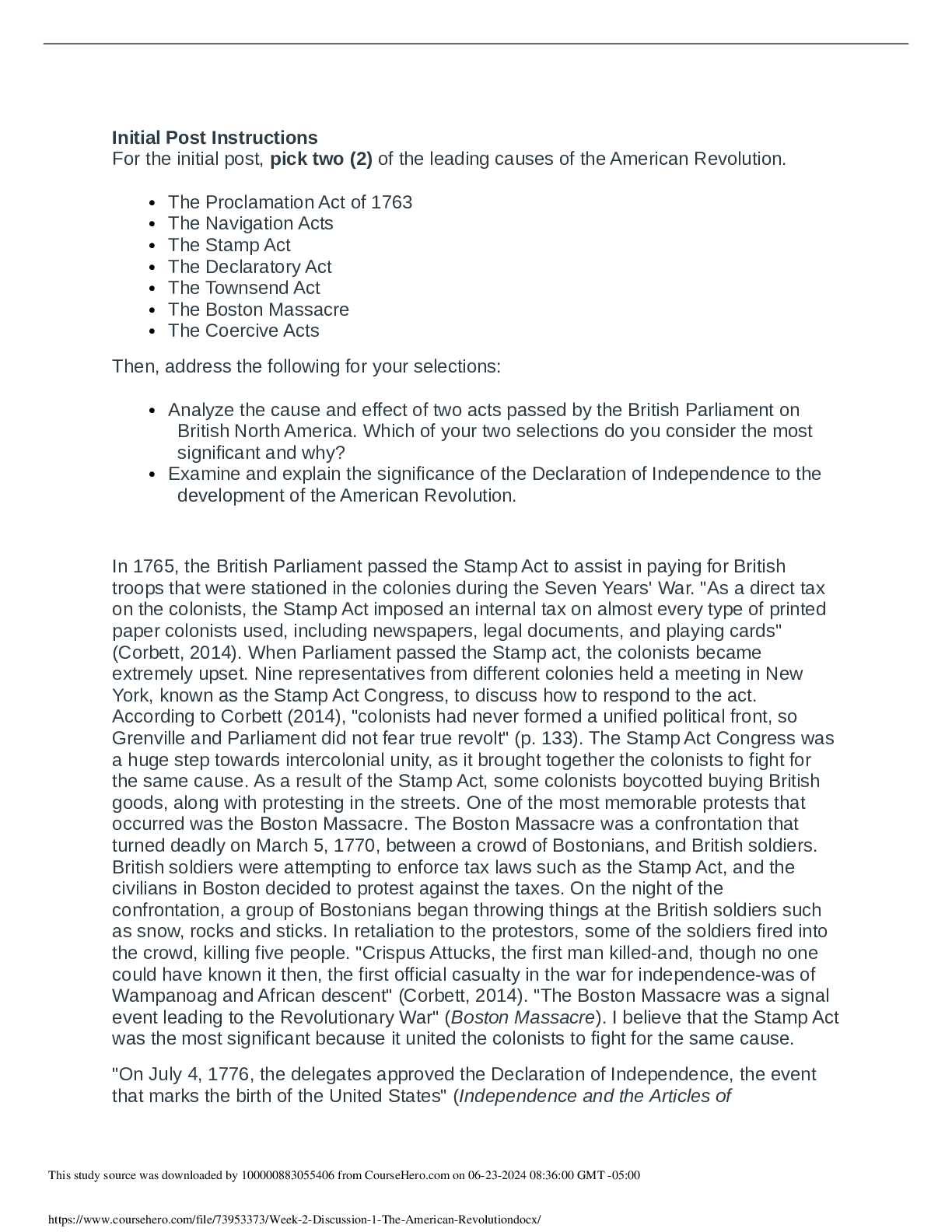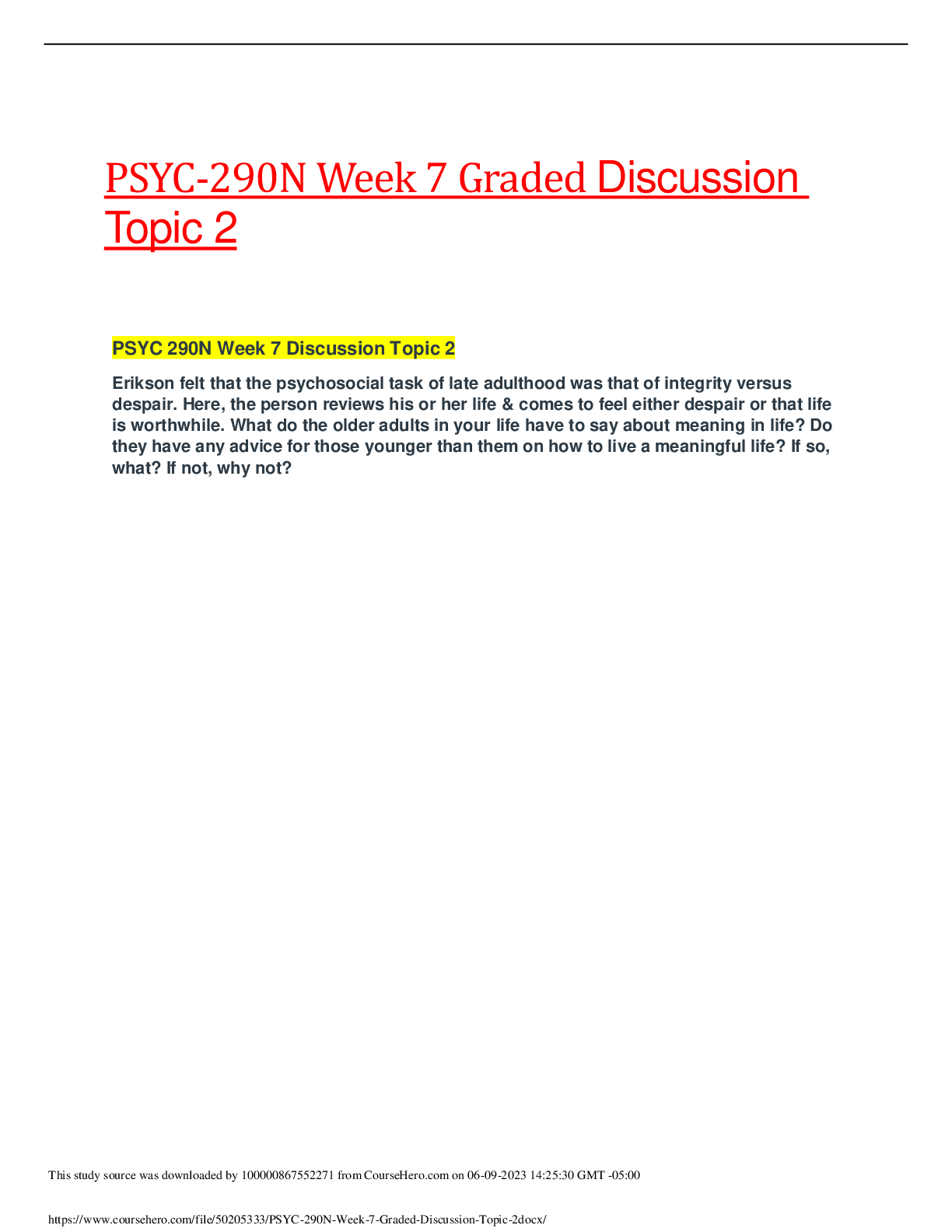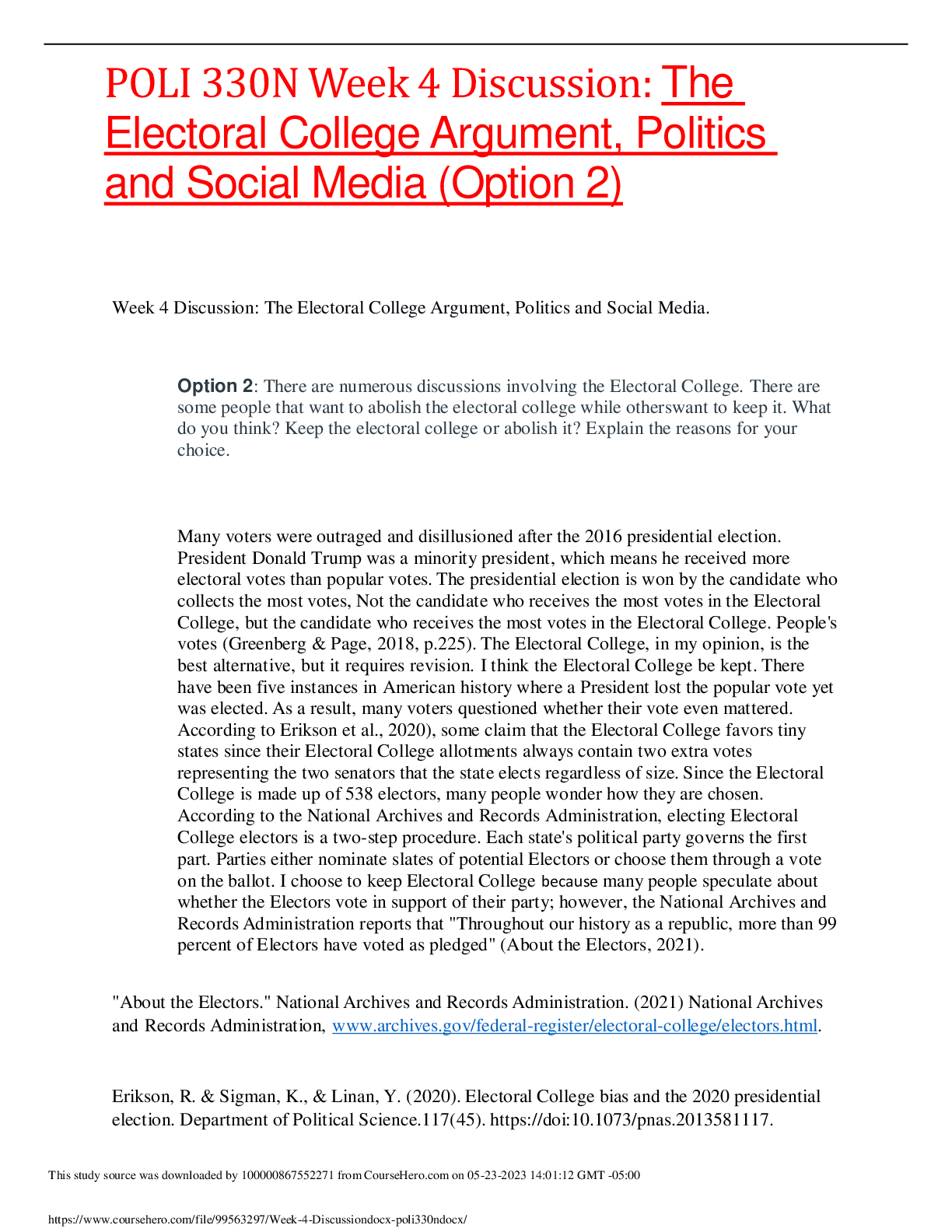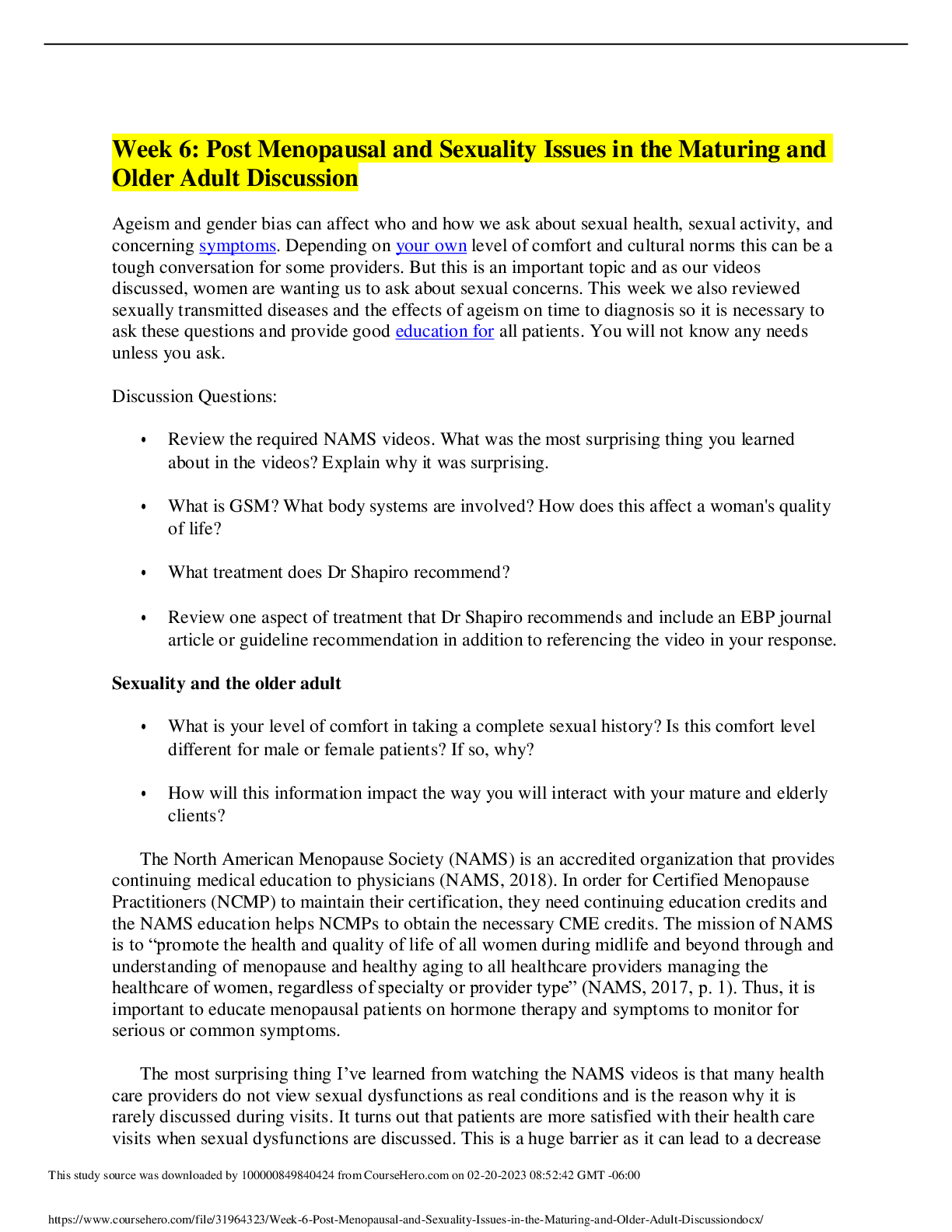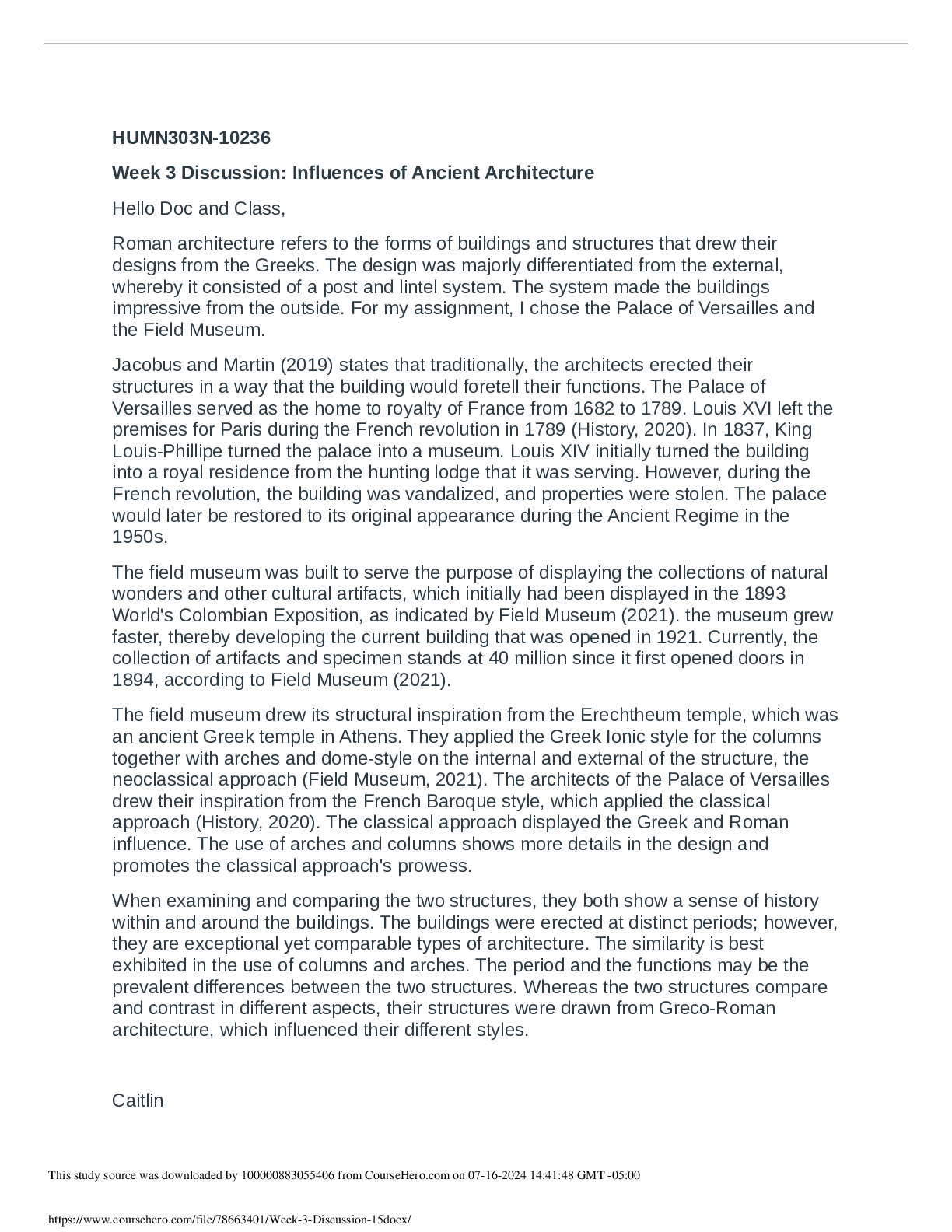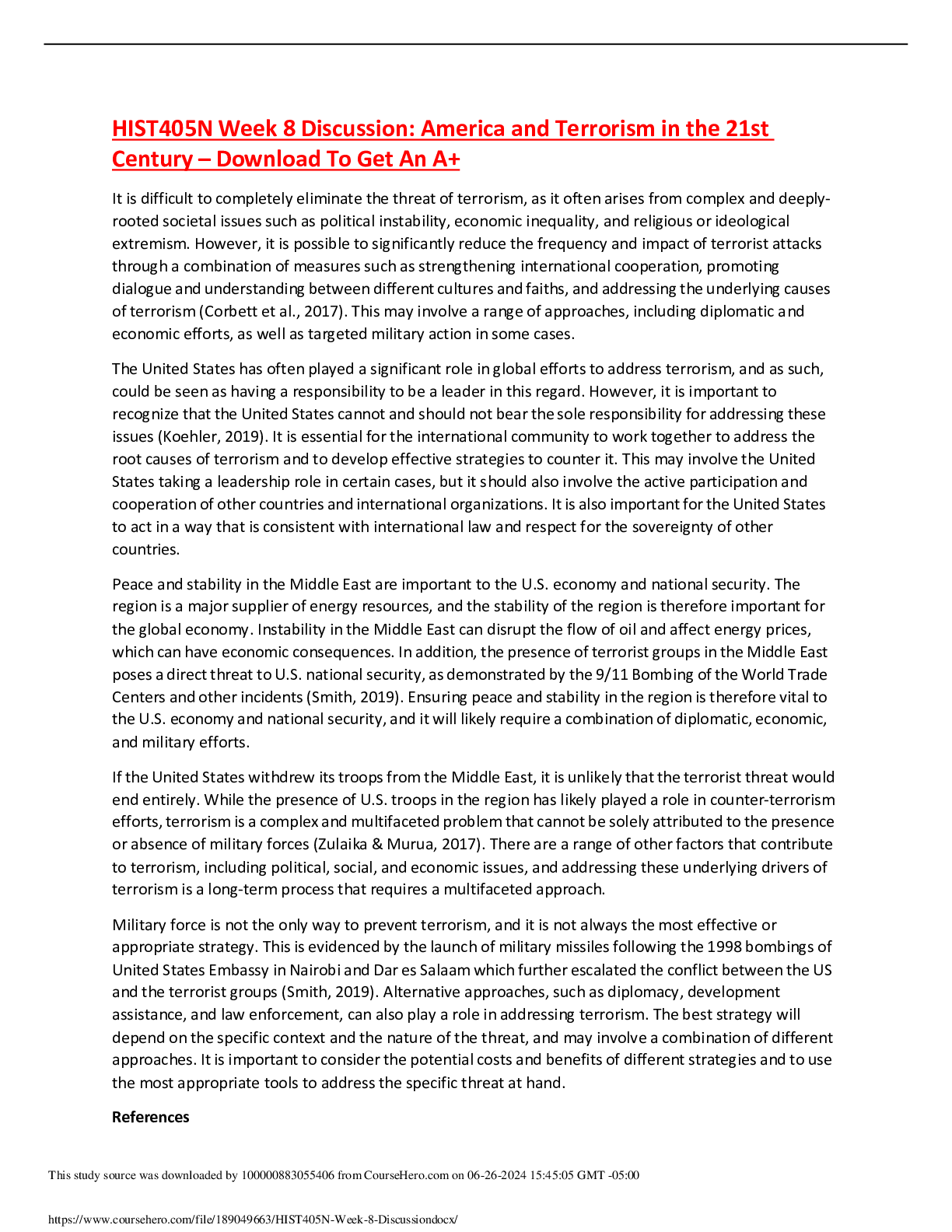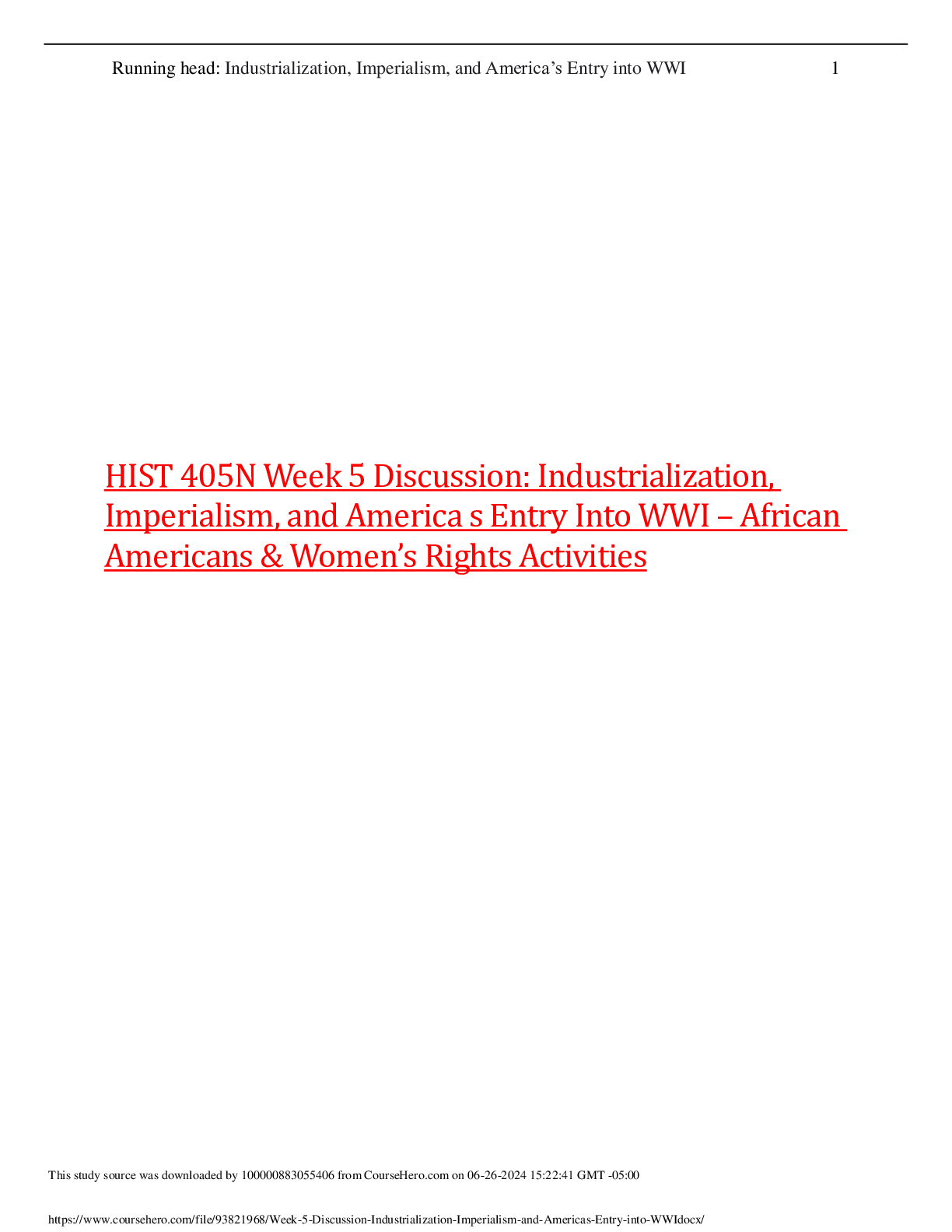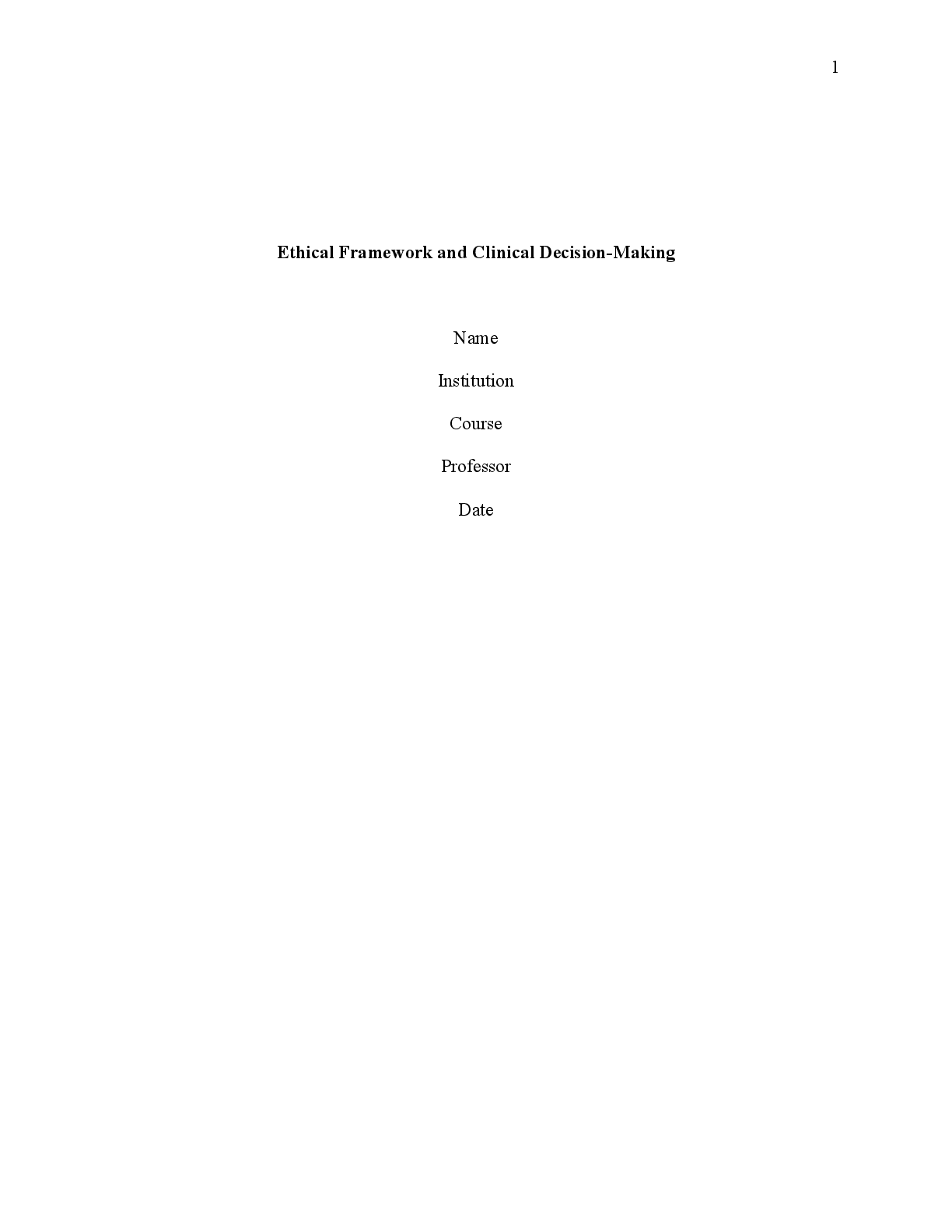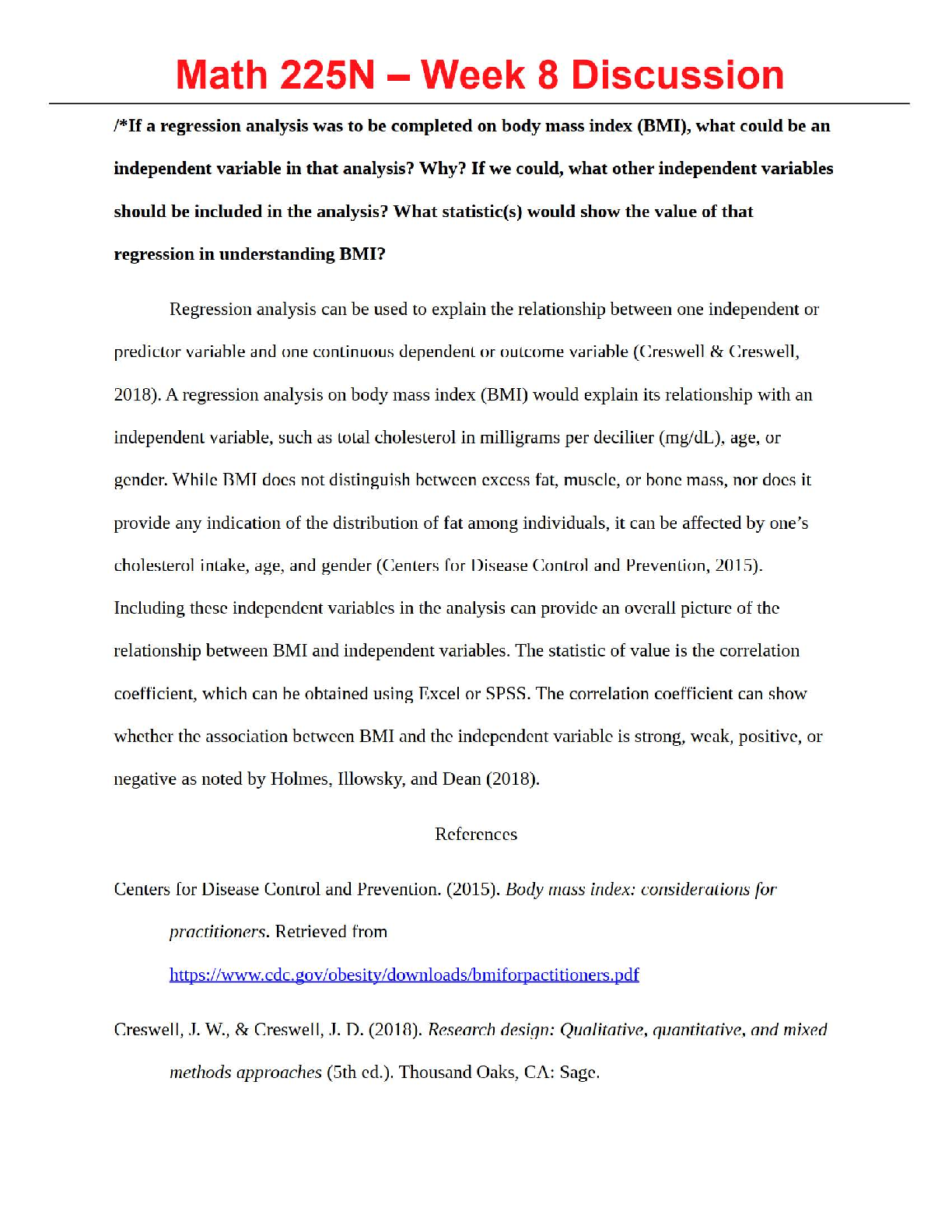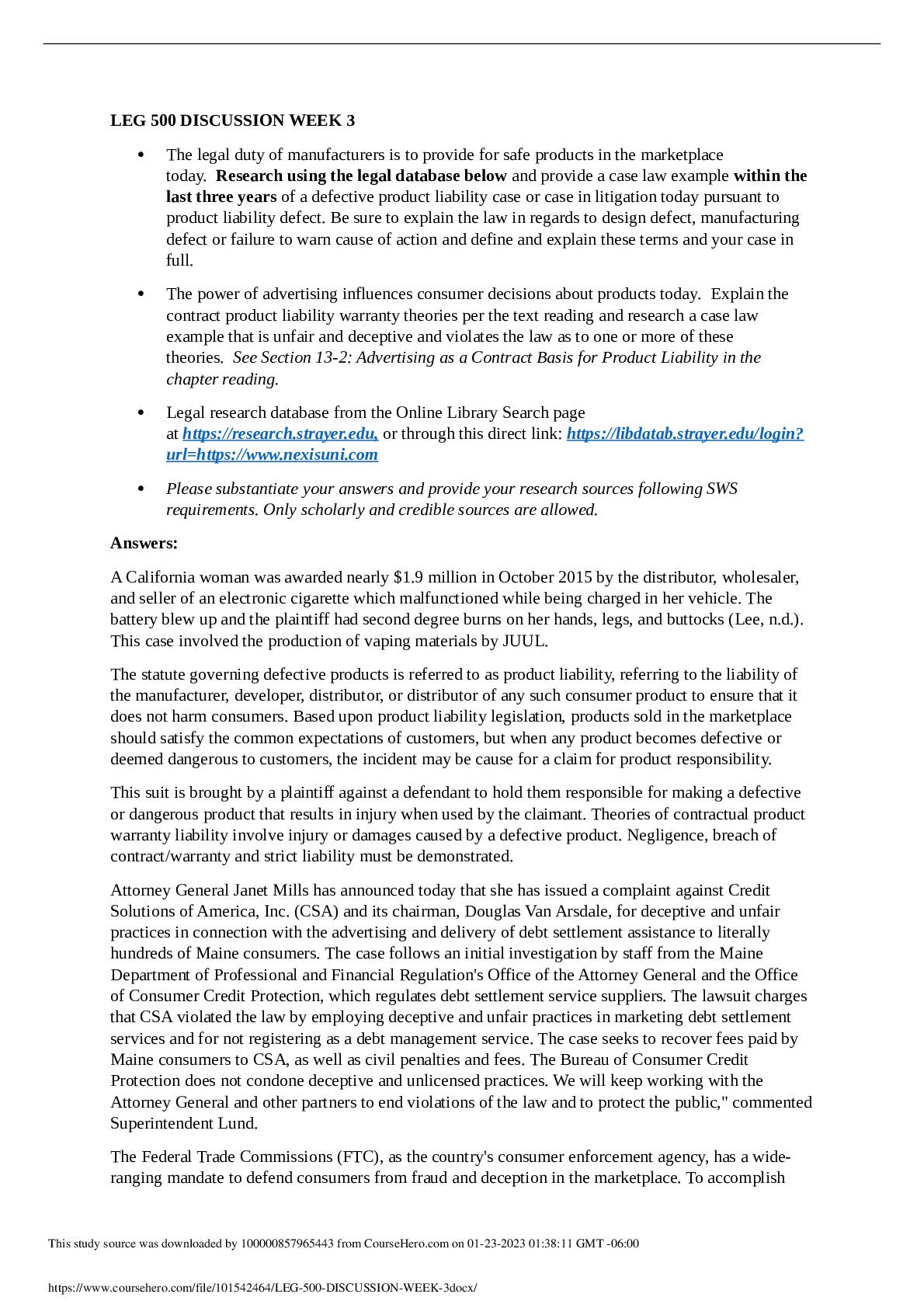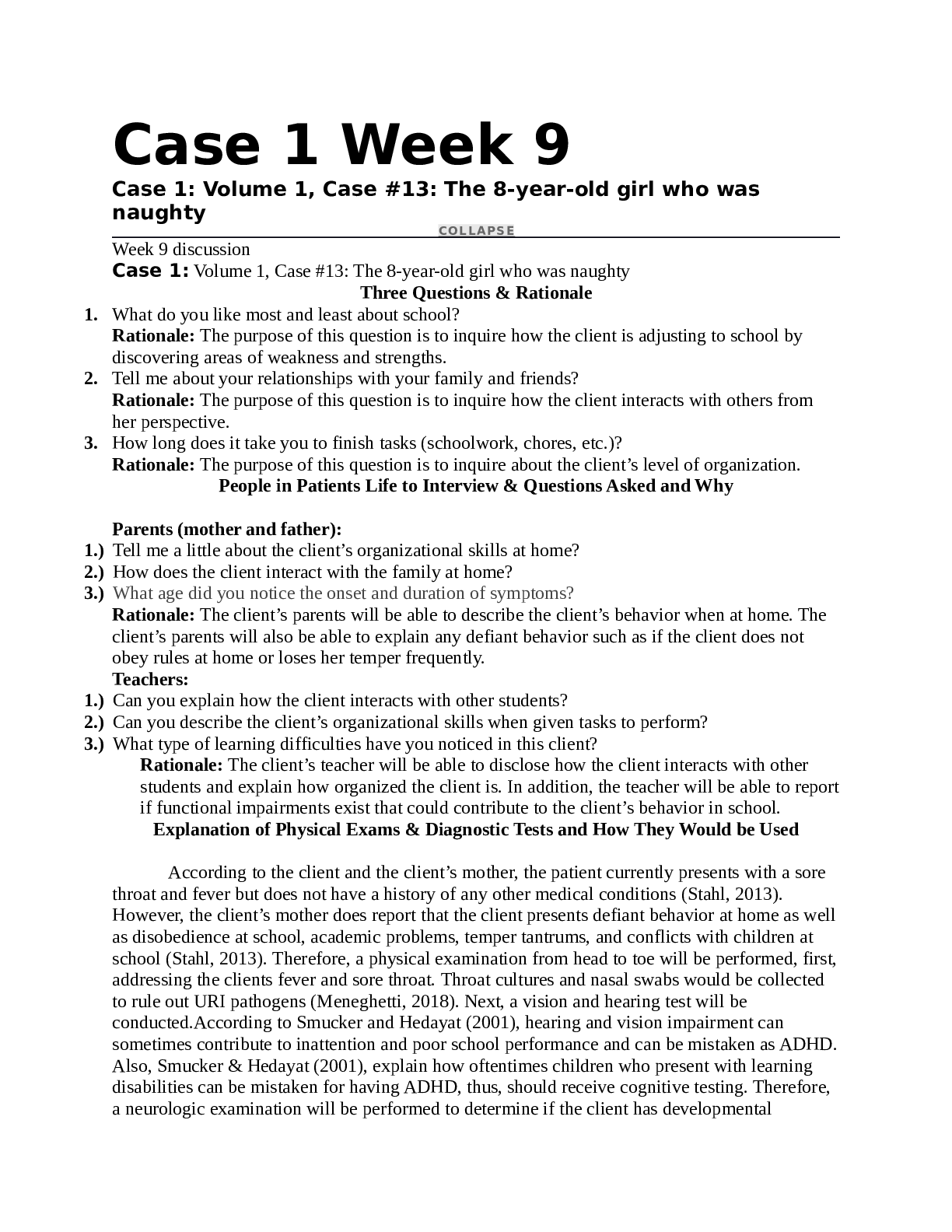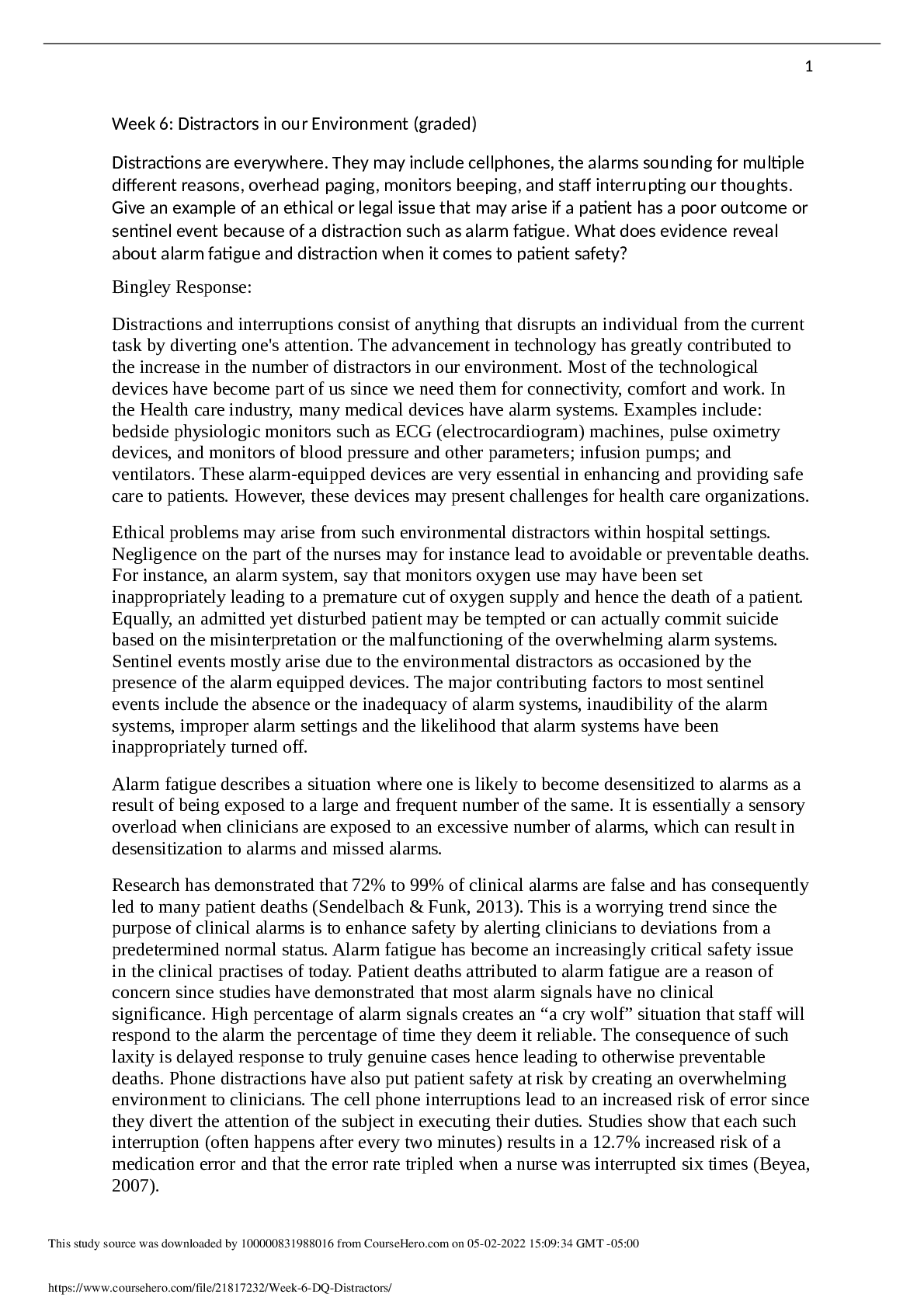Project Management > DISCUSSION POST > PROJ-410 Week 4 DQ 1 Evaluation Criteria - Graded An A (All)
PROJ-410 Week 4 DQ 1 Evaluation Criteria - Graded An A
Document Content and Description Below
Week 4 DQ1 Team Performance, Working Together Week 4 DQ2 Ethical or Moral Boundaries for Outsourcing ➢ Week 4 Project Controls Individual Assignment ➢ Week 4 Riordan Manufacturing HR an ... d Systems Redesign Project 1 Discussion Question 1 Team Performance, Working Together Working together, as a team, is always an important aspect of any project. If you are lacking the organizational values of the team, you will go astray and the project may go off course. If you are noticing the "ship" going off course, there are several things you can do to get things back on track. I have been on a couple of support forums, trying to increase my knowledge (and outside perspectives) on management. One of the ideas someone brought up, was that their team was highly stressed out. They were on edge and everyone was at each other's throats. The project manager could see the cohesive bond between his fellow teammates falling apart. He called a meeting. This put the people even more on edge, because the last thing they wanted was go to another 3 hour meeting. When they arrived in the meeting, the project manager had bought them tickets to go see the new movie, Lincoln: Vampire Hunter. After the movie, he sat down with the team for a "meeting" and talked over the strategy and focus of their mission. This did delay the project for half a day, but this took the edge off of the team, took them away from the situation, and brought cohesiveness back to the team. The project manager saw that there was a problem and tried an "out of the box" solution for this team. 2 Discussion Question Ethical or Moral Boundaries for Outsourcing In business, the ethic and moral line is a fine line that is written in sand, and is usually erased and moved, on a daily basis. Some companies walk it, balancing precariously, as to not to fall on one side or the other, while others have no problems straying off to one of the sides. When a business has a project that can be done by its current workers, but it can have the same job done by workers in another country for 1/10th cost, this can be ethical, in a business sense, but not morally sound. If money is your only reasoning, when you have more than capable "hands" at your disposal, you should use them. If you do not have the people for the project, and you need to outsource to other locations, then you have no ethical or moral boundaries you need to stay within, because you are meeting the needs of a project. You have a need and you are filling the position. There is no "line in the sand" that you have crossed, within a moral code or an ethical guideline. Sometimes, these are items that have to be justified when working within project boundaries. 3 CMGT 410 Week 4 Individual Assignment Project Controls ANALYSIS AND REPORTING OF UNPLANNED CHANGES: If any unplanned changes arise, during the training project, whether before or during the training session, will have to be reported immediately to the stakeholders involved, managers, and CEO, for approval. This will be a mandatory action, before any other will be taken. Unplanned changes will always be that: Unplanned. Some of these may include changes that exceed budget restraints originally included in the estimates. One of the ways we are going to prevent cost overruns will be to give passes to the trainees. The passes will have attached lanyards and they must be worn at all times. This will prevent competitors from showing to the event, gaining insight to our training, and providing a cost overrun. EVALUATION OF THE PROJECT QUALITY: Being the project manager, I will be determining the best practices to follow. Within these practices, I will determine which restrictions will be most significant, and which will be least significant, as to focus our monetary resources in the best possible way. If I do run into any complications, I will use the wisest reasoning in 4 coming to my conclusions, accounting for the best course of action, with the least amount of financial impact. The scope will always be considered the main focus of the project, with monetary impact of every decision being close at mind. The project will not land on a positive note, if the monetary reigns are not held tightly. More time may have to be deployed, to allow for shortcomings in the project estimates. This will ensure for project excellence. HANDLING CHANGE CONTROL: Change control will be addressed with the risk management aspect of the project management. These will comprise of: • Risk Control – the steps needed in order to reduce risk, provide contingency and monitor for improvements within the project. • Risk Assessment – all the aspects of identifying and analyzing the risks involved with a project. This may also include the loss probability that is involved within a project. To make sure risk is handled, all throughout the project, techniques may have to be employed to ensure all issues are handled in a timely manner. The following list includes ways to mitigate control and handle change issues: 5 1. Applying Scope Reduction – applying a performance evaluation upon the scope to see where any reductions in time can be managed. 2. Fast Tracking – applying two or more activities, simultaneously, so that time may be shortened within the scope, or budgeted time. 3. Additional Resources – assigning additional resources, like time, money, or people, so that risk management can occur. 4. Adopting higher risk – sometimes a project must adopt a higher risk to obtain a higher outcome. If a project is falling below its performance expectations, a higher risk might need to be maintained to reach its goal. COMMUNICATION OF PROJECT POTENTIAL: The following are key factors that will be under purview of the project and will be transposed to the stakeholders for review, if the current status of the project changes: Quality – the project shall be viewed for any quality changes in performance. Any standards that were set in the baseline estimates will be adhered to throughout the project. If those standards fail to be met, notifications will be sent out immediately. Cost – the stakeholders have the original estimates of the budget. If, at anytime, the costs were to overrun the original estimates, the stakeholders will be 6 immediately notified of any costs and where they will be incurred. All justifications will be addressed before any changes are made to the original plan. Resources – all resources will be addressed, and identified, during this project. If any unscheduled changes occur during the scheduled project plan, stakeholders will be notified at the earliest time frame possible. Resources include, but not limited to, the human resource aspect, as well as physical equipment considerations. Time – time will always be reviewed as the project progresses. If a problem arises, and time becomes an issue, a notification will be sent to the stakeholders, addressing the situation. If more time needs to be allotted, justification will be sent along with the time notification. 7 CMGT 410 Week 4 Riordan Manufacturing HR and Systems Redesign Project Table of Contents Riordan Charter Approach 10 Project Background 10 Current System 10 Areas of Improvement 11 Project Goals 11 Compatibility 11 Storage and Recovery Planning 11 Network 11 Security Systems 12 Phases of Production 12 Project conceptualization 12 Project development 12 Project design 12 Project construction 12 Project testing 12 Project implementation 13 Project evaluation 13 Budgetary Limitations 13 Explanation of Sponsor 13 Stakeholders 13 Structure of the Project Team 14 Project Approach 14 Project Schedule 15 Business Requirements Document 15 Compatibility of Systems 15 Storage and Recovery 16 8 Network Design and Security 17 Additional Security 19 Work Breakdown Structure 20 Project Costing 18 Resource Establishment……………………………………………………………………. 18 Timeline Establishment 18 Critical Task Sequencing 18 Cost Implications 19 Variance Baseline 20 Delegation of Variance Targets 20 Planned Versus Actual 21 Estimates Versus Planned 21 References 22 9 Riordan Charter Approach Project Background The purpose of this project will be to appropriate a new Human Resources Client-Server Database system. This new system’s capabilities of centralizing Riordan Manufacturing’s data will increase the overall security of the data within. This was expressed to the IT department because of the increasingly overwhelming amount of personal data currently transmitted across unsecure data-lines, within Riordan. Employee information is taken with the highest regard and securing that information is priority one. Because Riordan Manufacturing has several locations around the country, a centralized database system is needed to secure employee’s information, but remain accessible to the need to know employees that need access to it. The project will include the building of an inter-company network, capable of communicating between each of the offices. A network upgrade of each location, capable of handling the incoming and outgoing traffic of each location, and the hardware upgrades to the servers need to upgraded as well, able to handle the increased workload. Current System Riordan Manufacturing currently employs a human resource system that is antiquated and in need of improvement. The majority of the documents generated by the system are hard copy and stored onsite at each Riordan location. The possibility of an event that would cost the company critical documents would cause devastating effects. The current built-in redundancy is used to alleviate this issue; however an electronic system upgrade will alleviate possible future mishaps. Recovery planning is also lacking with Riordan Manufacturing possessing facilities across multiple nations acquiring access to data and storing it properly have become major concerns. Finally a need to integrate the different individual systems within the human resources 10 department has arisen. Reducing the number of applications required to run the current system would help increase overall productivity of the HR department. Areas of Improvement Some areas of improvement are storage, and backup capabilities, compatibility, and communication. The current system offers very little in the way of storage and recovery capabilities. A new system should offer each of its branch adequate storage and a centralized-hub for backing-up data among the sites Riordan Manufacturing owns. This central hub would be responsible for maintaining the branch data as well as implementing a recovery plan in the event there is data-loss at a particular branch office. Compatibility and communication are the last two factors to consider. Each branch's HR department will require a particular method of communication between the other branches. Compatibility with existing intranet protocols are considered necessary. The varying degree of equipment between each branch will be deemed compatible with multiple platforms to be best employed by each HR department branch office. Project Goals Compatibility Each branch maintains slightly different network systems. Plans to implement compatibility among each office and the devices in the office Storage and Recovery Planning Developing backup procedures, implementing company-wide, recovery plans need to be developed and offsite backup locations should also be considered Network Considerations will be implementing upgrading the entire network the new system will rely upon, in its current state it will not sufficiently support the 11 projected needs of the new system Security Systems Moving to an electronically dominated system will provide a better means for securing data and ensuring proper control and distribution Phases of Production The project will follow a series of phases during production. Each phase will reflect a goal in achieving a particular task and also the resources needed to reach that goal. These phases will be outlined by project: conceptualization, development, design, construction, testing, implementation, and evaluation. Project conceptualization. This phase will involve the collaboration and brainstorming of team members to determine an appropriate path for the consistency of the project. Project development. The development phase will entail the team creating a project charter and scope guidelines for the direction of the project. This stage will provide the boundaries of the project to adhere to as well as the goals to work toward. Project design. This phase will establish the layout of the project and will begin applying the functional aspects of the project design. The design stage will list the blueprint of the project along with the ideal operating guidelines. Project construction. At this phase, the project will begin to take form and will be built according to the design schematics. The team will build a working model of the desired project and apply the necessary details. Project testing. The testing phase will be a detailed process in testing all parameters of the constructed project. The main purpose of this phase is to find the bugs, and improve the areas in need. Project implementation. At this point, the project is ready for rollout. This phase will involve the process of presenting the project to its destination, and ensuring a successful transition with the existing technology. 12 Project evaluation. Upon completion of the project, an evaluation will be administered. This phase will monitor its functionality, and apply any adjustments necessary to run efficiently as planned. Budgetary Limitations According to the Virtual Organization portal (2012), the budget for this project is $2,008,000. Two cash payments are required of $250,000. The initial payment must be received by July 1, 2012 with the final payment paid by December 30, 2013. The remaining balance of $1,508,000 will be financed through a bank at an 8% interest rate. This loan will be paid within 60 months of the loan date. Replacement of current systems in four locations will cause limitations of the budget. The budget will require close monitoring and periodic revisions. The equipment for this project is not included in the $1,000,000 that Mr. McCauley has acquired for new equipment for each location. They are two different projects. Explanation of Sponsor Hugh McCauley is the Chief Operating Officer for Riordan Manufacturing. According to the Virtual Organization portal (2012), Mr. McCauley is calling for a more sophisticated, state-of-the-art information system. Mr. McCauley will be the contact person and project sponsor for this project. Mr. McCauley wants the system in place within six months. Stakeholders The stakeholders are anyone, internal or external who are affected by the project. Riordan Manufacturing stakeholders are: 1. Chief Executive Office- Michael Riordan is the founder and CEO of Riordan Manufacturing. In order to maintain growth, Mr. Riordan will be affected by this project because he wants to maximize the profitability of his company. 2. Senior Management- The management of the company wants to improve employee performance and maximize profit growth. 13 3. Human Resource Department- This department will profit tremendously from this project. All activities will be streamlined. All employee related issues will go through the HR. 4. Riordan Employees- The employees will be able to have all of their pertinent information collected and stored through this new system. Structure of the Project Team Project Team’s structure will begin with the sponsor who will sponsor the project. Following the sponsor is the project manager who handles the day-to-day operations of the project that includes scheduling and budgeting. The project manager is also responsible for the deliverables of the project. The project manager should be a strong and multitasking individual. Following the project manager, the project team consists of people from various areas of an IT department. A project team will have team leaders, programmers, testers, etc. Each member will have specified duties. The team leaders will work under the project manager. Depending on their part of the project, team members will be assigned under the team leaders. Project Approach In working toward the completion of the Human Resources client-server database system, the development team will be taking a project breakdown approach. Using the Work Breakdown Structure (WBS), the project’s stages will be seen in the form of deliverables in which each team member will be assigned as the project progresses. Achieving project milestones will be a weekly goal for the team. Each week a work package will be derived depicting the appropriate stages of work to achieve the next milestone. A project outline depicting the scope, the measureable organizational value (MOV) of the project, the necessary tasks to perform, and the potential milestones to achieve will be established as a guide for the project team. The project team will meet once a week for a review of progress, and to make sure that the project is progressing according to the scope. 14 Project Schedule Business Requirements Document In order to meet the goals outlined in the scope it is necessary to ensure during the system creation that the four goals are met. In order to build a complete work breakdown structure or WBS, it is necessary to further outline the expected results that will be used as the measurements for the achievement of the goals set. Compatibility of Systems To enable the new systems to work at peak performance it is necessary to ensure that all branches of Riordan are operating with the same technologies. This goal will be met when each branch has transition to an Ethernet network that is connected behind a local router and firewall. The brand of equipment to be used will be determined by the IT network staff and will be used in the same configuration in each location. To ensure software compatibility all workstations will be configured with the same operating system and with the same suites of tools needed per department. Hardware will be similar in nature, but this will not be as strict to branding but will include the same basic setup and will be governed by the minimum requirements set by the IT help desk. The purchase of these systems, software, and their peripheral devices will be handled by the IT help desk as well. Storage and Recovery The use of the new HR system design will contain a requirement to store all data on a server and to then access the data using a client-server architecture. The information will be available by using a system design that manages the data function as shown below (Myers, 2003). • Data Storage – Server based and backed up 15 • Data access logic – Will use an SQL based system • Application logic – Applications will run locally and access across the network • Presentation logic- Users will access the data via https via secure intranet The use of a client – server architecture has several benefits for the new HR system. One of the main goals is to provide a system that can be access from all locations and be able to store and access HR data from anywhere on the network. The client –server architecture will provide this use of the system while providing a back up, and maintaining a secure method to access this data. Client – Server database systems use a server to hold data that is used by the system. This data will be accessed by the client machines running an application that interacts with the servers that will be running SQL. There are many benefits to using this architecture starting with: • The data is centralized so that all users can work with it. This prevents multiple copies of the same information from being stored on multiple clients, reducing the security of information, and users not using the most up to date information available. • Security can be handled at the server level and enforces equally for all users. The database has the ability to enforce security through the use of constraints, stored procedures, triggers, and log in credentials. • Relational database server helps manage network traffic by limiting data to application needs. Unlike a full server based solution, a client – server architecture allows for only the return of data requested instead of having to download full files. This reduces the load put on the network by unneeded downloads and reduces the impact to server resources. • Hardware cost reduction. Hardware can be optimized for the portion of the process that it will support only. Clients will not need to be configured with large data storage as their disk space will not be storing data. Servers will not be displaying data so they will not be wasting 16 processing power. The server will be easier to secure than that of a system where sensitive information could be contained on multiple computers. • Maintenance cost will be lower than other options. The server will provide a lower maintenance cost because of all the data being stored in one location. Data will be backed up to a second server instead of trying to back up large amounts of data from multiple machines. This provides for cleaner, more stable backups of data (Microsoft, 2012). Network Design and Security The Network design required to support this system is a common network for organizations such as Riordan who have locations outside of one geographical area. In order for the different locations to talk to the central or main location the network will use secure firewalls to create VPN tunnels from each location to the central location where the server is stored. This VPN tunnel creates a secure Virtual Private Network that allows for the communication of sensitive information in a secure environment. Clients that are working outside of a main office will be able to connect via a VPN connection and also access information as needed (FortiGate,2005). See Figure 1. 17 Figure 1 Additional Security Routers are used behind the firewall to manage connections on the network and the passing of data. In the case of the HR system, the routers will also be used to further secure the data by placing all HR client machines and servers in separate vlans and creating access control lists in the routers to only allow access from approved client machines to the server vlan. System security will also be implemented on the application as all information that will be passed will be done by using HTTPS. This information 18 transfer will only happen after the successful log-in credentials are supplied and the user is verified to have access to the requested information. (Dell Force10, 2012). Work Breakdown Structure 19 20 21 22 Project Costing Resource Establishment The HR Resource Deployment project will entail the use of 11 resource genres that will make up the organizational structure of the project rollout. These resources include: • Project Manager • Network Administrator I • Network Administrator II • Deployment Administrator • Desktop Administrator • Database Administrator • Test Q/A Analyst • Workspace Coordinators • Stakeholders CEO Senior Management • HR Management • Education/Training Lead Timeline Establishment The HR Resource Development project timeline will range from July 10, 2012 to December 11, 2013, covering a span of 17 months of total planning and execution. Duration estimates were derived from the estimated time of acquiring buy-in from stakeholders, establishment of each project process, compilation of all major milestones, and the projection of planned instance durations. Estimates were applied through past experience, compiled project data, and the collaboration of stakeholders. Critical Task Sequencing The project will detail an array of critical task sequences including: 23 • Pre-project Envisioning – Evaluation of HR database and corporate objectives, formulation of cost/benefit analysis, establishment of project scope and major milestones, securing of executive sponsorship and buy-in • Planning Structure – Project assembly, computing and testing environments, preliminary design, system array, and maintenance orientation • System deployment – Deployment of hardware and software systems, pilot test evaluations • Post-Implementation Review – Backup/restore maintenance, performance monitoring, system re-forecasting, establishment of ongoing infrastructure team Cost Implications Resource cost report will equate to $23,606 per each week of the project threshold. Cost is based on a combined hourly rate per each resource over a 40 hour work week for a projected 18 months. The estimated cost of resource wages compiles to $1,841,328. Additional costs will include hardware, leased lines, maintenance, office supplies, postage, shipping, software licenses, subscriptions, and telephones. The estimated cost of additional equipment and supplies amounts to $167,300, which brings the total project cost to $2,008,628. 24 Figure 2 Variance Baseline Achieving the desired outcome for the HR Resource Deployment will require a stringent and concentrated focus on maintaining adherence to the project timeline. Throughout this timeline, variance data will be closely observed and documented. Capturing variance data is an adamant goal for the project managers. Variance data will help to expose possible weaknesses of the planning process, and serve as priceless information for future endeavors. Suchan (2012) indicates some leading practices involving the application of variance data. The means of collecting variance data will be comprised of the following: Delegation of variance targets. Prior to the project start, prime areas of variance will be decided upon for tracking. These areas will be closely monitored and documented. Targeted variances will form the baseline of the project, and will consist of measurements of quality, project milestones achieved, performance metrics, and budget adherence. The success versus failure Planned versus actual. Variance data will be looked at according to what is planned as opposed to what the actual outcome will be. This will largely be focused on the proposed scheduling timeline and project cost expectancies. As the project advances, variance data will be tracked according to what 25 deviates from the planned objectives. This data will be captured in real time in order to provide insight for future milestone proceedings. Estimates versus planned. This variance metric will focus on what was estimated for project details, such as schedule and cost, prior to the approved project plan. Such data will assist in greater accuracy of project planning, and will help to eliminate the guessing game. These variance metrics will be acquired through the collaboration between all stakeholders and resources. 26 References: Apollo Group. (2012). Riordan MTG. HRIS. Retrieved from https://ecampus.phoenix.edu /secure/aapd/cist/vop/Business/Riordan/HR/HRIS.asp Dennis, A., Wixom, B. H., & Roth, R. M. (2009). System Analysis and Design (4th ed.). Hoboken, NJ: John Wiley & Sons. Fortigate. (2005). Fortinet. Fortigate VPN Guide. Retrieved June 20, 2012 from http://docs.fortinet.com/fgt/archives/3.0/techdocs/FortiGate_IPSec_VPN_User_Guide_01 -30005-0065-20081015.pdf Laudon, K. C., & Laudon, J. P. (2010). Management Information Systems (11th ed.). Upper Saddle River, NJ: Prentice Hall. Microsoft (2012) Microsoft TechNet. Chapter 7 Client/Server Architecture. Retrieved March 21, 2012 from http://technet.microsoft.com/en-us/library/cc917543.aspx Myers, C.R. (2003) Cornell University Library. Software Systems As Complex Networks. Retreieved June 20, 2012 from http://arxiv.org/abs/cond-mat/00305575 Suchan, J. (2012). Leading Practices for Applying Variance Data to Future Projects. Microsoft Office. Retrieved from http://office.microsoft.com/en-us/project-help/leading-practices- for-applying-variance-data-to-future-projects-HA010174487.aspx Valacich, J. S., George, J. F., & Hoffer, J. A. (2009). Essentials of Systems Analysis and Design (4th ed.). Upper Saddle River, NJ: Prentice Hall Virtual Organization (2012). Riordan Manufacturing. Retrieved from http://Ecampus.phoenix.edu 27 [Show More]
Last updated: 2 years ago
Preview 1 out of 27 pages
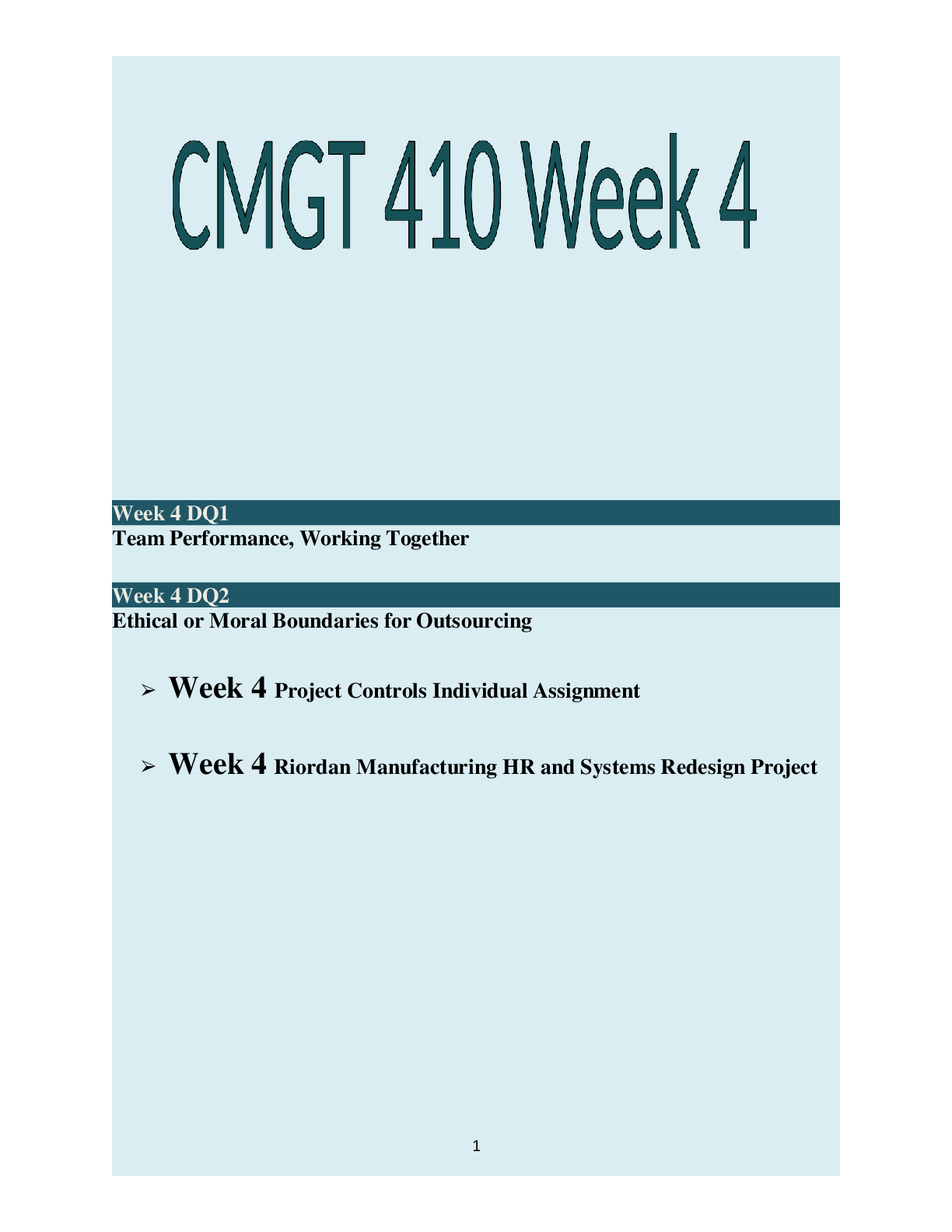
Buy this document to get the full access instantly
Instant Download Access after purchase
Buy NowInstant download
We Accept:

Also available in bundle (1)
Click Below to Access Bundle(s)

PROJ 410 Contracts And Procurement
PROJ 410 Week 1 DQ 1 Procurement in Projects PROJ-410 Week 1 DQ 2 Contract vs Project Management PROJ 410 Week 2 DQ 1 Contract Pricing Options PROJ-410 Week 2 DQ 2 Project Control PROJ 410 Week 3...
By Doc.Mukai Edyth 2 years ago
$15
11
Reviews( 0 )
$10.00
Can't find what you want? Try our AI powered Search
Document information
Connected school, study & course
About the document
Uploaded On
May 27, 2023
Number of pages
27
Written in
All
Additional information
This document has been written for:
Uploaded
May 27, 2023
Downloads
0
Views
137

